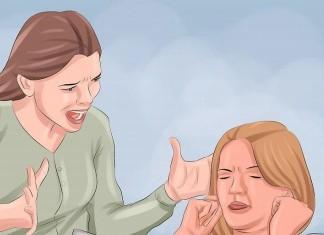14.3 Parents and Teens: Autonomy and Attachment
While most adolescents get along with their parents, they do spend less time with them (Smetana, 2011). This decrease in the time spent with families may be a reflection of a teenager’s greater desire for independence or autonomy. It can be difficult for many parents to deal with this desire for autonomy. However, it is normal for teenagers to increasingly distance themselves and establish relationships outside of their families in preparation for adulthood.
Children in middle and late childhood are increasingly given greater freedom regarding basic decision-making. This continues in adolescence, as teens demand more and more control over the decisions that affect their daily lives. Teens believe they should manage the areas that parents previously had considerable control over, which can increase tension between parents and their teenagers. Their arguments often center on issues of a power struggle or conflict in areas such as chores, homework, curfew, dating, personal appearance, and the right to privacy.

Figure 14.2. Teenagers report more conflicts with their mothers. (Image by Wikivisual is licensed under CC BY-NC-SA 3.0.)
As teens grow older, more compromise is reached between parents and teenagers (Smetana, 2011). Teens report more conflict with their mothers, as many mothers believe they should still have some control over many of these areas, yet often report their mothers to be more encouraging and supportive (Costigan, Cauce, & Etchison, 2007). Parents are more controlling of daughters, especially early maturing girls than they are sons (Caspi, Lynam, Moffitt, & Silva, 1993). In addition, culture and ethnicity also play a role in how restrictive parents are with the daily lives of their children (Chen, Vansteenkiste, Beyers, Soensens, & Van Petegem, 2013).
Having supportive, less conflict-ridden relationships with parents also benefits teenagers. Research on attachment in adolescence finds that teens who are still securely attached to their parents have fewer emotional problems (Rawatlal, Kliewer & Pillay, 2015), are less likely to engage in drug abuse and other criminal behaviors (Meeus, Branje & Overbeek, 2004), and have more positive peer relationships (Shomaker & Furman, 2009). This means that both parents and teenagers need to strike a balance between autonomy while still maintaining close and caring familial relationships.
14.3.1 The Parent-Child Relationship
The relationship with parents may be a mitigating factor to the negative influence of peers. Communicating family rules and parental style have been inversely associated with substance, alcohol, and tobacco consumption during adolescence. This influence is essential for adolescents’ development up to adulthood. Communication between parents and adolescents emerges as a protective factor for alcohol, tobacco, and substance use (Newman, Harrison & Dashiff, 2008).
Sen (2010) observed that family meals could lead to creating a closer relationship between parents and adolescents by strengthening a positive relationship and avoiding certain risky behaviors, such as substance use among girls and alcohol consumption, physical violence, and robberies among boys. These differences between genders may be due to the greater importance that girls attribute to family activities. Still, they do not reveal that boys are indifferent to them, only that the relation between genders may differ. Huebner and Howell (2003) verified that parental monitoring and communication with parents protected adolescents of both genders from being involved in risky behaviors.
14.3.2 Friendships in Adolescence
Peers are an important source of social support and companionship during adolescence. As children become adolescents, they usually begin spending more time with their peers and less time with their families, and these peer interactions are increasingly unsupervised by adults. The level of influence that peers can have over an adolescent makes these relationships particularly important in their personal development. Adolescents with positive peer relationships are happier and better adjusted than those who are socially isolated or have conflictual peer relationships.
Adolescents’ notions of friendship increasingly focus on intimate exchanges of thoughts and feelings, which are important to forming friendships; these high-quality friendships may enhance a child’s development regardless of the particular characteristics of those friends. In addition, peers are an important source of social support and companionship during adolescence.
The peer group may serve as a model, influence behaviors and attitudes, and provide easy access, encouragement, and an appropriate social setting for consumption (Glaser, Shelton & Bree, 2010). Social Learning Theory suggests that it is not necessary for adolescents to observe a given behavior and adopt it; it is sufficient to perceive that the peer group accepts it to be able to opt for similar behaviors (Petraitis, Flay & Miller, 1995).
Peers can serve both positive and negative functions during adolescence. Relationships with peers are valuable opportunities for adolescents to practice their social and conflict-resolution skills. But negative peer pressure can lead adolescents to make riskier decisions or engage in more problematic behavior than alone or in their family’s presence. One of the most widely studied aspects of adolescent peer influence is deviant peer contagion (Dishion & Tipsord, 2011), which is the process by which peers reinforce problem behavior by laughing or showing other signs of approval that then increase the likelihood of future problem behavior.

Figure 14.3. Adolescent boys drinking at a party. (Image by theopie is licensed under CC BY 2.0)
Peers may strongly determine preference in the way of dressing, speaking, using illicit substances, sexual behavior, adopting and accepting violence, adopting criminal and antisocial behaviors, and in many other areas of the adolescent’s life (Padilla, Walker & Bean, 2009; Tomé, Matos & Diniz, 2008). An example of this is that the main motives for alcohol consumption given by adolescents are related to social events, which usually take place in the company of friends, namely: drinking makes holidays more fun, it facilitates approaching others, it helps relaxing or facilitates sharing experiences and feelings (Kuntsche, Knibbe, Gmel & Engels, 2005). Also, mimicking risk behaviors may be greater when consumption begins in the context of a social event (Larsen, Engels, Souren, Granic & Overbeek, 2010).
On the other hand, having friends allows us to share experiences and feelings and to learn how to solve conflicts. On the other hand, not having friends leads to social isolation and limited social contacts, as there are fewer opportunities to develop new relations and social interactional skills.
Friendship is also positively associated with psychological well-being (Ueno, 2004), Stronger friendships may provide adolescents with an appropriate environment to develop in a healthy way and to achieve good academic results. Adolescents with reciprocal friendships mention high levels of feelings of belonging in school; at the same time, reciprocity and feelings of belonging have positive effects on academic results (Vaquera & Kao, 2008).
School is a setting where interpersonal relations are promoted, which are important for youngsters’ personal and social development (Ruini et al., 2009); it is responsible for the transmission of behavioral norms and standards, and it represents an essential role in the adolescent’s socialization process. The school is able to gather different peer communities and promote self-esteem and harmonious development between adolescents, which makes it a privileged space for meetings and interactions (Baptista, Tomé, Matos, Gaspar & Cruz, 2008). Adolescents spend a great part of their time at school, making it a privileged context for involvement in or protection from risky behaviors (Piko & Kovács, 2010). Camacho, Tomé, Matos, Gamito, and Diniz (2010) confirmed that adolescents who like school were those that more often were part of a peer group without involvement in risk behaviors; while those that mentioned they did not have any friends reported that they liked school less and those in conflict with their peers had more negative health outcomes.

Figure 14.4. These teens are at a concert together. (Image by Eva Rinaldi is licensed under CC BY-SA 2.0.)
Despite the positive influence of the peer group during adolescence, the higher the adolescent’s autonomy from the peer group, the higher their resilience against its influence. This resilience seems to increase with age, which may mean that it is associated with youngsters’ maturity, and girls emerge in several studies as more resilient than boys (Sumter, Bokhorst, Steinberg & Westenberg, 2009).
Another factor that may be found in the influence of the peer group is the type of friendship that adolescents maintain with their peer group: if friends are close, they have a greater influence on the other’s behaviors (Glaser, Shelton & Bree, 2010). When the friendship is perceived as reciprocal and of quality, it exerts greater influence (Mercken, Snijders, Steglich, Vartiainen & Vries, 2010). Another factor, which has been identified as a possible way of decreasing peer influence, is assertive refusal. Adolescents that can maintain an assertive refusal are less susceptible to the group’s influence (Glaser, Shelton & Bree, 2010). These are only some variables identified as possible factors decreasing peer influence.
14.3.3 Teen Friendships and Technology
The rising use of technology and social media has made a significant impact not only on how adolescents maintain friendships, but also on how they initially form friendships. Technology such as social media and messaging has made it possible to be in instant communication with friends without limits to time or physical location. While the use of technology has a positive impact on social support and helping adolescents feel more connected to their peers, it can also have a negative impact of contributing to adolescents’ stress with the need to be always available to their peers.
The way in which adolescents form their friendships has been greatly impacted by the use of technology. While it used to be that friendships were formed through meeting peers in school or extra-curricular activities, this limit no longer exists. Adolescents no longer need to meet peers in-person to form friendships, as many of these friendships are now formed online. A national survey conducted by the Pew Research Center (2015) found that 57% of adolescents formed at least one new friendship online, with 29% of adolescents forming five new friendships online. The friendships that are formed online tend to remain digital; only 20% of adolescents meet an online friend in person.
For more information about teen friendship and technology please visit this link: Pew Research Center.
